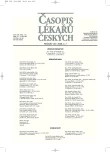Nitric Oxide Synthase, Typical Flavohemoprotein and Their Complicated Enzymology
Authors:
M. Jáchymová; B. S. Masters 1; K. Horký 2; T. Zima 3; P. Martásek 4
Authors‘ workplace:
Laboratoř molekulární kardiologie Ústavu klinické biochemie a laboratorní diagnostiky 1. LF UK a VFN, Praha
; Department of Biochemistry UTHSC at San Antonio, Texas, USA
1; II. interní klinika 1. LF UK a VFN, Praha
2; Ústav klinické biochemie a laboratorní diagnostiky 1. LF UK a VFN, Praha
3; Klinika dětského a dorostového lékařství 1. LF UK a VFN, Praha
4
Published in:
Čas. Lék. čes. 2006; 145: 526-531
Category:
Review Article
Overview
Nitric oxide is a diatomic gaseous molecule with unpaired electron in the molecule. Physical properties such as solubility, diffusibility and half-life decide the chemical reactivity of nitric oxide. Nitric oxide is the unstable free radical in vessels, immune system and central nervous system. The reactivity of nitric oxide under physiological and pathological conditions depends upon its concentration and site of production. Nitric oxide is thought to play a role in many pathological situations: septic shock, cardiovascular diseases, arthritis, diabetes, multiple sclerosis, asthma, and hypertension. Nitric oxide synthase is a self-sufficient flavohemoprotein capable of producing nitric oxide from L-arginine by two successive monooxygenation steps. Although the N-terminal heme domain functionally resembles cytochromes P450, no structural similarities exist between cytochrome P450 and nitric oxide synthases heme domains. The C-terminal domain of nitric oxide synthases containing flavin adenine dinucleotide and flavin mononucleotide as cofactors exhibits a high degree of sequence similarity with NADPH-cytocrome P450 reductase. The reductase domains serve as an intermediary for the transfer of electrons from NADPH for the catalytic reaction. The connecting domain between the oxygenase and the reductase domains of nitric oxide synthase isoforms binds calmodulin in the presence of calcium. The binding of calmodulin to all nitric oxide synthase isoforms is obligatory for the production of nitric oxide. At the same time, the presence of one or more phosphorylation sites in nitric oxide synthase puts them among the kinase-mediated signaling pathways. This also means that nitric oxide synthases are regulated indirectly by the events that regulate kinases. This field of research of nitric oxide synthase regulation has become one of the most actively pursued and much has been learned from basic biochemical mechanisms to physiological processes and to medical applications, but many more questions still remain to be answered.
Key words:
nitric oxide, nitric oxide synthases, electron transfer, protein-protein interaction.
Labels
Addictology Allergology and clinical immunology Angiology Audiology Clinical biochemistry Dermatology & STDs Paediatric gastroenterology Paediatric surgery Paediatric cardiology Paediatric neurology Paediatric ENT Paediatric psychiatry Paediatric rheumatology Diabetology Pharmacy Vascular surgery Pain management Dental HygienistArticle was published in
Journal of Czech Physicians

Most read in this issue
- Autosomal Recessive Ethnical Diseases of Czech Roma
- Paediatric and Adolescence Gynaecology in Czech Republic
- Hippocampus, Structure of the Brain and Schizophrenia
- Trends in the Clinical Biochemistry and Laboratory Diagnostics
